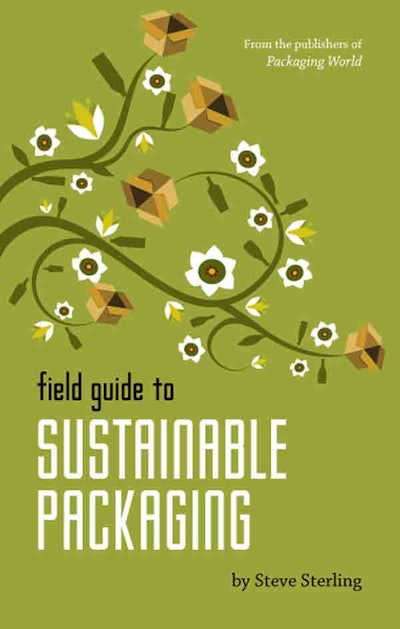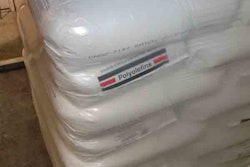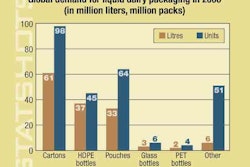
we asked Contributing Editor Steve Sterling if he could produce a book on the subject. Why a book? Because it’s such a sturdy frame on which to hang a discussion about something as rich and complex as sustainable packaging. It also provides ample opportunity to explore some of the background to the whole sustainable packaging movement that has now gained so much momentum. You can order your very own copy of this new book at www.packworld.com/fieldguide. We proudly present here excerpts from the soon-to-be-published Field Guide to Sustainable Packaging, by Steve Sterling.
In 1972, Stuart Rose, then in his early 20s, was hired as a management trainee at British clothing, décor, and food retailer Marks & Spencer. That same year, 5,000 miles away, production in the
It would be 34 years before declining oil reserves, environmental legislation, and a bestseller once again intersected with the career of Stuart Rose. When they did, he was in a position to do something extraordinary.
Compliance with environmental regulations does not come cheap for citizens, businesses, or governments. Waste disposal and greenhouse gas emissions are now also the domain of regulators. By December 31, 2008, for example, Europeans must recover 60 percent of all packaging waste and reach an overall recycling level of 55 percent. The directive is a “producer responsibility” measure—producers have to meet the costs of achieving these targets. In the
One generally unrecognized fact about today’s culture is that every person—rich or poor, CEO or mail clerk—is exposed through movies, radio, television, newspapers, magazines, and the Internet to basically the same news, issues, facts, and conflicting opinions. Because of sameness in information, business leaders are no longer as isolated in their executive suites as they once were. Executives are just as glued to CNN and other news outlets during emergencies as anyone else. They are exposed to the same culture as everyone else. They are no different from anyone else in wanting the best for their children and grandchildren. With all the publicity swirling around An Inconvenient Truth and global warming, is it any wonder that Rose became interested? And so it is that our Field Guide discussion returns to Mr. Rose.
So ends this short tale of how the career of Stuart Rose intersected—not once but twice—the trend lines of history. As we journey forward in this Field Guide to Sustainable Packaging, we will see that he is far from alone in recognizing sustainability as an absolute business requirement going forward. But a look at his role as a catalyst in broadening global awareness of sustainable packaging is an excellent jumping off point for the pages that follow. How firm is Rose’s belief in the finality and importance of Plan A? Consider his answer when asked why it was named as it was: “We call it Plan A because there is no Plan B.”
Several years ago, Norm Thompson, an Oregon-based catalog and Web retailer, calculated that it saved approximately $1,154,000 annually in materials cost, labor, and shipping by using lightweight polyethylene bags rather than heavier corrugated cases for shipping non-breakable items to customers. Energy savings roughly equated to 110,000 gallons of gasoline. The reduction of greenhouse gas emissions exceeded 1,100 metric tons of carbon dioxide per year, about the same benefit as removing 210 passenger cars from the road. The company reduced its packaging material consumption by 627 tons when polyethylene bags rather than corrugated boxes and fill materials were utilized.
“When most people hear about sustainable packaging for the first time, they envision renewable materials and recycling as the attributes needed to achieve sustainability,” says Patty Enneking, director of global sustainability and environmental affairs at Klöckner Pentaplast. “The optimum solution for a packaging application may not include a renewable or recyclable material, as the DEQ study for shipping nonbreakables indicates.”
So if a package can be called “sustainable” even if the materials from which it is made are not necessarily “green” themselves, then what is the definition of a sustainable package? This is where the Sustainable Packaging Coalition comes in. But first, a little background.
It seems the SPC is speaking in a 21st century language while the rest of the industry is fluent only in its 20th century packaging vernacular. Look at the consternation over the Wal-Mart scorecard. The mega-retailer is asking for measurements most companies have not previously made, let alone have an efficient and cost-effective means of collecting. What the packaging industry needs is a Rosetta stone, a key that unlocks the sustainable packaging language and permits a manageable, clear, and measurable transition from a 20th century paradigm to 21st century best practices. The industry requires an intermediary means of objectively determining whether a proposed package design is more sustainable than the package it will replace.
The SPC definition of sustainable packaging is the current definitive vision statement for the industry. The definition explains the underlying concepts for sustainable practices and points the way to the future. How companies move from today to tomorrow will be an individual journey assisted along the way by materials suppliers, equipment manufacturers, converters, transporters, customers, end users, universities, and a host of industry groups. It does not matter whether a company uses the reduce/reuse/recycle shorthand for sustainability, the Wal-Mart scorecard, or a methodology of its own making. What does matter is whether every new package improves on the package it replaces in terms of lowering environmental, social, and economic impacts.
This industry should not become stuck on what to call its drive toward sustainability. Remember what Shakespeare had to say on the subject: “What’s in a name? That which we call a rose by any other name would smell as sweet.”
A few months later, Kistler was reported in Packaging World magazine as basically holding that line. He said during a meeting with suppliers, “On Wal-Mart buyer decisions, all things being equal, the better score wins. Even close calls can tip the scales toward the better score.” Packaging World editor Rick Lingle reported this reaction after the presentation from one meeting attendee, a packaging materials manager from a major consumer packaged goods company: “[the scorecard] is a ticking time bomb.”
This mindset is certainly understandable. The one-year timeframe for scorecard implementation, the low level of knowledge about sustainability in general, lack of benchmark data, the scorecard data entry process, and the fear of losing orders—these are the key factors causing an undercurrent of consternation across the supplier base. Hardly anyone is talking about it. Who in their right mind would want to stand out in public and criticize a customer with the buying power of Wal-Mart? Behind the scenes, however, Wal-Mart is likely receiving the message that suppliers are deeply concerned. It would not be surprising to find Wal-Mart quietly moderating its stance and easing off the scorecard throttle.
The CEOs who choose this strategic route will have to communicate their vision for sustainable practices internally as well as externally. This helps everyone in the organization, from senior management all the way down to part time personnel, know that sustainability is as important to the success of the enterprise as productivity and quality. The CEO will emphasize that sustainability is every employee’s responsibility. This means, for example, that electricians must be empowered to look for ways of replacing energy guzzling electric motors with more efficient ones. Plant personnel will have to devise ways of reducing greenhouse gas emissions. And managers would be wise to encourage telecommuting so that less gasoline is consumed. Like Rose and Scott, CEOs know that no one company can do it all on its own. This will require that CEOs engage with suppliers and customers and share their vision for sustainable practices.
Sustainable programs begin with benchmarking. The organization needs to identify key indicators, determine where it stands in relation to those indicators, and then have a means of measuring gains. Energy usage, carbon emissions, fleet mileage, types and quantities of materials consumed, and waste are some of the more important and perhaps easiest places to start.
The sustainability journey can begin by benchmarking a package or family of packages in terms of materials, energy and water usage, waste generation, and greenhouse gases. Packaging managers can then gradually move the pack toward sourcing less material. At the same time, they can develop plans for reducing total energy consumption, water pollution, and air emissions and factor in a strategy for end-of-life recovery, alternative use, or environmentally friendly disposal. Benchmarking and measurement are essential, but packaging managers should be careful not to complicate the process.
“At least in the early days of the process, keep the parameters you want to measure as simple as possible,” advises Graham Houlder, global packaging coordinator-Foods, Unilever. “For example, is the material for the target package renewable or nonrenewable? If it is non-renewable, is it recyclable or recoverable? Begin to move materials content toward the sustainability end of the scale... Your goal is to begin to reduce the environmental footprint of the package.
“In six months or a year, managers who have measured key metrics will be able to show the improvements they’ve made, even if these are small ones,” he says. “Positive stories motivate and create a bandwagon effect internally as well as with suppliers, retailers, customers, and share holders.”
Another shared experience is that every successful implementation took time. Outcomes were cumulative and based on incremental improvements. There were few instant breakthroughs for these companies. Each company, whether they called the effort sustainability or cost reduction, had a goal, designed a solution, and then implemented it. Time and effort underpin the positive results.



























